Seeking comfort is a vital endeavor for obtaining pleasure in life. This comfort can be derived from different daily life activities like taking a nap on a pillow, or mattress, or slipping your shoes into cozy and snuggly shoes. These tiny luxuries make up a huge part of daily routines.
Today society has evolved and so does its needs. Slippers are a source of pleasure derived from the comfort that humans actively seek in their daily life. The need for slippers has also evolved over the years and so does its service.
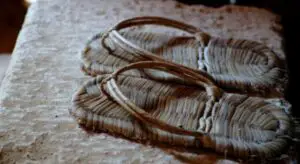
The study about today’s role of slippers is wide but here in this article, we would discuss the history of slippers and the journey of their evolution. The article would discuss when, where, and how slippers use has changed over the passage of years.
The general perception of slippers is not that complex rather they are considered as a mundane object that fits quite right into the coterie of our daily life footwear but there is more than that to the history of slippers.
Most people are not aware of the evolution of slippers and yet it makes an interesting topic. Design, aesthetics, and materials used in slippers manufacturing have evolved into a wider sphere.
However, seeking comfort and warmth for feet is still the core purpose behind the use of slippers and it is subject to great importance. A slipper can have aesthetic pleasure but if it is not cozy for feet, it has already defeated its purpose.
History of Slippers
Origin
The English language coined the word ‘slipper’ for the first time in 1478 but slippers have been around as footwear even before that.
However, 15,000 years old Spanish cave drawings depict that humans used to wear slippers of animal pelt and fur even in those times. The origin of slippers dates back to 200AD.
During 2008, at Boscombe Down roman bodies were in the process of digging, and a woman with slippers was identified. All the other bodies were wearing traditional boats but slippers depicted the higher social status of that woman.
Invention
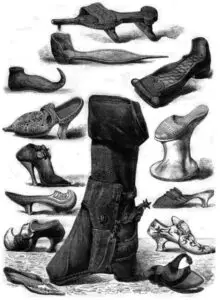
It is obvious that the concept of slippers as footwear has been around for much longer than our imagination can conceive. However, there is a disparity in facts when it comes to finding out who invented the slippers.
The fact is vague but online internet research suggests that it was Alvin Slipper who invented the first slipper.
The reason that drove him toward this invention is stated that he felt his feet were too cold. This reason behind invention cannot be considered true and it might be just an urban myth. The idea of Alvin Slipper was restricted to indoor shoes and lounge shoes.
Some of the studies state that it was Florence Melton who invented slippers in the 1940s inadvertently and by chance. She discovered the slipper material; Foam. This happened while she was fixing and tweaking the properties of helmets worn by the soldiers during World War II.
Foam has several properties and the dominant ones are softness and viable to wash. Slippers made from foam were comfortable due to softness and they were easy to clean. Hence, they made good slippers for soldiers.
In fact, this was the invention of pure need and Milton herself stated this back in 2001.
She went on to say,
“I always thought in terms of filling a need”.
Melton’s discovery led to the invention of the first foam soled and washable slipper and to the Dearfoams brand, which is still around today.
When?
It can be stated that modern society slippers are based on the inspirational model of either Melton’s or Slipper.
However, the first recorded mention of slippers stems back to the 12th century in Vietnam.
Slippers are a symbol of comfort and cozy luxury nowadays but back then the story behind the slipper use was different. It didn’t stand for signifying comfort and satisfaction.
Rather it depicted the captivity of the person who was wearing slippers in those times. It was the mean of assurance that servants would not run away. Female servants of aristocratic sultans wore these slippers as they had soft soles and were a loose fit.
It was an onerous task to run with this footwear on tough, slopping, rocky terrains outside. Thus, this prevented maids to run away and still stay inside the castles to render services.
The Babouche
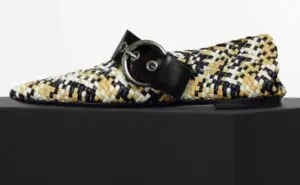
However, a few centuries down the road there has been a modification in the purpose of slipper usage and it was used for a much less sinister purpose. These changes happened in the development of slippers in the Middle East.
The Moroccan introduced the babouche and it was derived from the Arabic word ‘babush’ or Persian ‘papush’. The design of babouches is particularly inspired by the open-back sandals.
The notable feature of these babouches in particular is the exaggerated point at the toes. The design of this footwear depicted luxury and often monarchs preferred a comfortable lifestyle. The slippers had a unique, extra soft design whose property patently reflected the fact that its owner had great value and respect for their appearance and lifestyle.
For instance, 17th-century French courtiers often wore slippers to exert their majesty and show their social status. They lived a life that was both comfortable and luxurious, served by the drivers and gophers for their needs. Their servant ensured that their slippers and other footwear remain in good conditions while they were indulging in the comforts of life beyond the reach of lower social classes.
The babouche softness is not a natural property rather it was achieved after processing the material through a certain procedure. The babouche is subjected to continuous cleaning and drying until the desired level of softness is achieved.
However, the babouche has also evolved over centuries but still, artisan babouche is preferred. Artisan babouches are still being manufactured in parts of the world like Morocco, Marrakech, etc and it has become a sort of cultural icon for these regions.
The Furlane
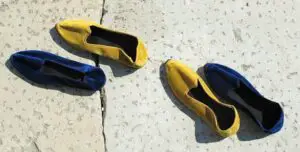
Another use of slippers was introduced to the world by Italians.
During the 16th century, the Gondoliers became famous around the world with their use of the Venetian Furlane as footwear material. Furlane retained the comfort and softness properties of the slippers yet is it served to more particular purpose at that time.
The furlane slipper had soles made from the molten, old tires of the bicycle. This offered enough friction between the slippers and the contact surface to prevent slippage.
The Furlane slippers also ensured that Gondoliers didn’t stain the paint on the Gondolas. The furlane slippers had velvet upper made from old clothing like curtains and dresses. These preserved the aesthetics and regal qualities pertinent to the Venetian Culture.
The shoes were artisan and purely manufactured by adroit hands to preserve the integrity of qualities. These furlane slippers have great importance in the cultural context and can still be found in Venice. Their rich historical taste has been a massive source of attraction for tourists.
The Prince Albert Slippers
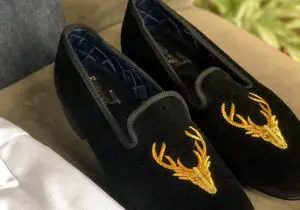
Comfort and elegance have been associated with slippers even if we move our focus into the Victorian era.
This elegance, comfort, and aesthetics can be seen reflected by the ‘Prince Albert Slippers”. These slippers have an upper made from leather and this design was introduced by Queen Victoria’s husband. It was his idea of using leather and thus named after him.
Slippers were quite a definition of elegance and luxury as they were made with velvet with soles of leather and lined with silk. They were worn by aristocratic families and symbolized a higher social status. They fit nicely with black dining suits. It was a common trend to wear slippers on dinner suits and it was not considered as unusual as it would be in modern society.
These slippers were initially worn for purpose of dinner, resting in-home, indoor movements, smoking, and visiting clubs. A new term has been coined recently and it is now called “smoking shoes”. In the 1940s and 50s, these slippers were worn by celebrities like Peter Lawford and Douglas Fairbanks Jr. Modern actors like Ryan Gosling and rapper Kanye West also have been spotted wearing these slippers.
Smoking slippers can endow the wearer with a gentlemanly look that is both sleek and chic. This charm can be achieved by donning smoking slippers with any suit, dress, and attire. Every outfit choice of the season can be picked to suit these smoking slippers. Smoking slippers can be worn on casual, fancy, skinny clothing.
Uwakbuki Slippers
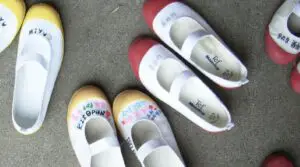
Japanese culture restricts people to take off their shoes outside whether they are entering a hotel, school, or house.
The enterer would have to swap shoes with pair of slippers that are usually already there. This is considered as a sign of reverence and it represents the belief that feet need rest after the hectic routine of the day. These light slippers that are to be swapped with shoes left outside are called uwabuki.
They are made from different types of material. The core purpose of these slippers is to offer comfort and pleasure to the feet. They are loose footwear and usually preferred for indoor movements.
Why a Slipper is Called a Slipper?
The word slipper is derived from the verb “To slip on”. Slippers are comfortable, soft, and loose footwear. It was hard to run with these slippers or do any difficult work.
They offer more slippage than any other shoe while exerting. There was less friction offered by these shoes.
It was a common thing to slip while wearing these shoes. Thus slipper word came from the tendency of this footwear to make the wearer slip.
The name was used in the 12th century by a southern song dynasty officer. He described two kinds of slippers being worn in Vietnam.
What Were Slippers Made From?
Throughout history, various materials have been used for manufacturing slippers.
Early known slippers were made from the bark of sagebrush woven to form an intricate structure of shoes.
Pine and sometimes rabbit fur was used for increased softness and level of comfort. In these times, workers would make footwear from scrapes.
Melton slippers were made from foam. It was soft and washable with ease. The slippers worn in Chinese courts in the early era as 4700BC were made from woven rush, cotton with leather linings. Further, they were embellished with symbols like dragons.
American moccasion depicted nature and beadwork was done on them.
Prince Albert Slippers had a leather sole and quilted lining.
The furlane slippers were made from fur and soles were made from rubber tires.
What Do They Call Slippers in America?
Slippers in America go by different names like moccasion, smoking slippers, flip-flops, etc.
These shoes are called flip-flop because of the sound they produce when the wearer walks. While walking rubber soles keep slapping the bottom of feet and that slapping sound resembles ‘flip flop’.
Moccasion design is simple and manufactured while producing minimum waste. They are usually manufactured from the animals’ skin, soft leathers usually deerskin. These slippers are associated with Native American Culture.
Furthermore, embellishment like beadwork and needlework is done to give them an aesthetically rich look.
Conclusion
Apart from the furlane slippers, Japanese uwakbuki and other shoes discussed above, the world has traveled far on the road of revolutions.
There have been a variety of slippers introduced to society by the western and other countries in the 21st century. The purpose of these slippers is to provide comfort, pleasure, and low cost to consumers.
Modern society offers the pleasure of slippers to people of all social classes. There has been a wide range of slippers available for different purposes.
For example, western countries have introduced driving slippers and bathing slippers, etc.
But the groundwork for modern-day footwear was laid by the work of ancestors. The world is rapidly progressing and there is still a lot to come in the world of footwear.

